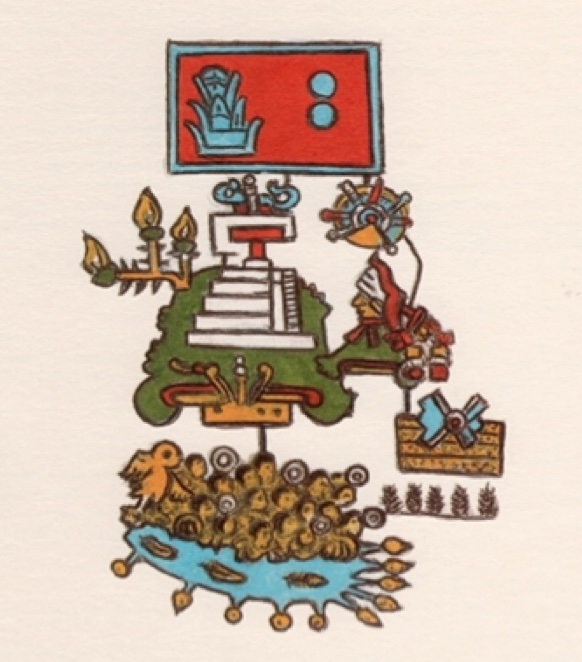Seismologists and anthropologists identified some of the earliest written records of earthquakes in the Americas in ancient documents.
By Meghomita Das, Department of Earth & Planetary Sciences, McGill University, Montreal, Canada (@meghomita)
Citation: Das, M., 2021, First written records of earthquakes in ancient Mesoamerica reported, Temblor, http://doi.org/10.32858/temblor.206
– Translation of a pictogram from the codex Telleriano Remensis
To a historian, this record might seem like a general documentation of events in the past. For seismologists, however, this priceless line is one of the first written and dated records of an earthquake in the Americas.
Codices, or ancient written manuscripts, such as the Telleriano Remensis quoted above, provide researchers with a window into the daily lives of civilizations. Historians use codices to understand how such civilizations operated in the past and how people viewed the universe. These manuscripts contain vital information about religious and political organizations, public and private traditions, astronomical knowledge and natural phenomena.
Recently, scientists started using Mesoamerican codices to understand where and when earthquakes occurred in the pre-Hispanic Americas, long before seismic instrumentation was commonplace.

In a recent study published in Seismological Research Letters, seismologist Gerardo Suarez at Universidad Nacional Autonoma de Mexico and social anthropologist Virginia Garcia-Acosta at Centro de Investigaciones y Estudios Superiores en Antropologia Social present the documentation of 12 earthquakes in Telleriano Remensis, spanning 1460-1542. The discovery extends the seismic record back five centuries further than previously known.
A rare pictographic record
Codices are written in a sophisticated pictographic language of signs and colors with each pictogram serving a specific purpose. Written by trained scholars called tlacuilos (in Nahautl language meaning “those who write painting”), these codices and annals were deemed evidence for paganistic beliefs and burned in public pyres during the Spanish conquests.
Only a few Mesoamerican codices survived. Some were translated by Franciscan friars to prevent the obliteration of the indigenous civilizations, making these codices extremely rare and valuable firsthand documents of Mesoamerican cultures.
Tlalollin: movement of the Earth
In the codex Telleriano Remensis, earthquake, or tlalollin (from Nahautl language), is represented by two symbols: movement, or ollin, and Earth, or tlalli.

Each event within the codex is accompanied by a gloss, or commentary, that explains the pictograms and translates them into Latin, Spanish or Italian. These translations were not done by the original tlacuilos but probably later by the Franciscan friars. “Our interpretation of the records comes from the glosses that were probably added later by the friars. So, a lot of it could be lost in translation,” said Suarez, a seismologist and lead author of this study.
In general, the earthquakes reported in the Telleriano Remensis are not accompanied by other information such as location or effects of shaking. This lack of detail hinders the seismological interpretation of these events, but the records are still valuable. They illuminate major earthquakes with long recurrence times. “It is important to collect, classify and interpret these data as more information may appear in the future that will allow us to draw more educated conclusions,” Suarez said.
Out of the earthquakes noted, two are corroborated by other documents that also contain information about the resulting damage. The researchers correlated records in the Telleriano Remensis of an earthquake in 1469 with descriptions in another text of landslides and damage to Yope sites near the Guerrero Gap, a recently seismically quiet part of the Mexican Subduction Zone. The documents point out a history of potentially large, damaging earthquakes in the region. (A magnitude-7.0 earthquake recently struck near the gap, offshore of Acapulco.)
With complementary information from other codices such as Aubin and Mexicanus, the researchers found evidence that another earthquake in 1475 caused significant damage in Mexico City, formerly the Aztec capital. Historians and seismologists speculate that this event may have occurred on a crustal fault of the Trans-Mexican volcanic belt, similar to the 1912 magnitude-6.9 Acambay earthquake that struck 50 miles (80 kilometers) from Mexico City.

Verifying the ancient records
As more ancient documents that mention earthquakes and other natural phenomenon are discovered across different civilizations, these historic datapoints can be referenced on modern-day seismic maps. The records can help researchers develop a more comprehensive understanding of earthquakes and how ancient civilizations responded to such disasters.
“If we want to use these documents to improve seismic hazard assessment, then we must cross-reference these studies with paleo-seismological studies or survey the damage to buildings in archaeological remains,” said Andy Combey, a doctoral student in archaeoseismology at the University Grenoble Alpes, who was not associated with this study. “It is a very complex study that requires multiple approaches.”
References
Suárez, G., & García‐Acosta, V. (2021). The First Written Accounts of Pre‐Hispanic Earthquakes in the Americas. Seismological Research Letters. https://doi.org/10.1785/0220210161
Further Reading
García Acosta, V., and G. Suárez (1996). Los sismos en la historia de México, Vol. 1, Fondo de Cultura Económica/CIESAS/UNAM, Mexico City, Mexico (in Spanish) 770 pp.
sismoshistoricos.org: A website documenting historical earthquakes in Mexico (in Spanish)
Rodríguez-Pascua, M. A., Pérez-López, R., Garduño-Monroy, V. H., Perucha, M. A., & Israde-Alcántara, I. (2017). Estimation of the epicentral area of the 1912 Acambay earthquake (M 6.9, Mexico) determined from the earthquake archaeological effects (EAE) and the ESI07 macroseismic scale. Quaternary International, 451, 74-86.
Combey, A., Tricoche, A., Audin, L., Gandreau, D., Escóbar, C. B., Abuhadba, J. B., … & Rodríguez-Pascua, M. Á. (2021). Monumental Inca remains and past seismic disasters: A relational database to support archaeoseismological investigations and cultural heritage preservation in the Andes. Journal of South American Earth Sciences, 111, 103447.
- Earthquake science illuminates landslide behavior - June 13, 2025
- Destruction and Transformation: Lessons learned from the 2015 Gorkha, Nepal, earthquake - April 25, 2025
- Knock, knock, knocking on your door – the Julian earthquake in southern California issues reminder to be prepared - April 24, 2025
